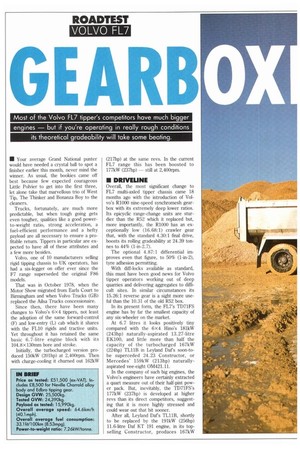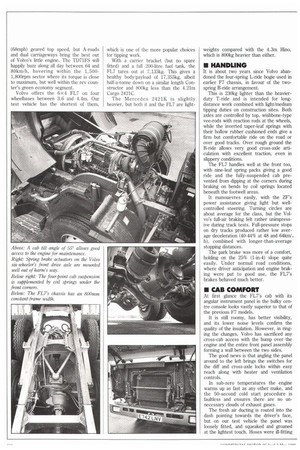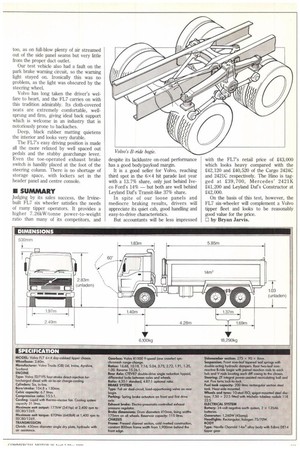GE A R 13 Most of the Volvo FL7 tipper's competitors
Page 100

Page 101

Page 102

Page 103

If you've noticed an error in this article please click here to report it so we can fix it.
have much bigger engines — but if you're operating in really rough conditions its theoretical gradeability will take some beating.
• Your average Grand National punter would have needed a crystal ball to spot a finisher earlier this month, never mind the winner. As usual, the bookies came off best because few expected courageous Little Polvier to get into the first three, let alone take that marvellous trio of West Tip, The Thinker and Bonanza Boy to the cleaners.
Trucks, fortunately, are much more predictable, but when tough going gets even tougher, qualities like a good powerto-weight ratio, strong acceleration, a fuel-efficient performance and a hefty payload are all necessary to ensure a profitable return. Tippers in particular are expected to have all of these attributes and a few more besides.
Volvo, one of 10 manufacturers selling rigid tipping chassis to UK operators, has had a six-legger on offer ever since the F7 range superseded the original F86 models.
That was in October 1978, when the Motor Show migrated from Earls Court to Birmingham and when Volvo Trucks (GB) replaced the Ailsa Trucks concessionaire.
Since then, there have been many changes to Volvo's 6x4 tippers, not least the adoption of the same forward-control (F) and low-entry (L) cab which it shares with the FLIO rigids and tractive units. Yet throughout it has retained the same basic 6.7-litre engine block with its 104.8x 130min bore and stroke.
Initially, the turbocharged version produced 150kW (201hp) at 2,400rpm. Then with charge-cooling it churned out 162kW
(217hp) at the same revs. In the current FL7 range this has been boosted to 177kW (237hp) — still at 2,400rpm.
• DRIVEL1NE
Overall, the most significant change to FL7 multi-aided tipper chassis came 18 months ago with the introduction of Volvo's R1000 nine-speed synchromesh gearbox with its extremely deep lower ratios. Its epicyclic range-change units are sturdier than the R52 which it replaced but, more importantly, the R1000 has an exceptionally low (16.68:1) crawler gear that, with the standard 4.30:1 final drive, boosts its rolling gradeability at 24.39 tonnes to 44% (1-in-2.7).
The optional 4.87:1 differential improves even that figure, to 50% (1-in-2), tyre adhesion permitting.
With diff-locks available as standard, this must have been good news for Volvo tipper operators working out of deep quarries and delivering aggregates to difficult sites. In similar circumstances its 15.26:1 reverse gear is a sight more useful than the 10.31 of the old R52 box.
In its present form, the FL7's TE071FS engine has by far the smallest capacity of any six-wheeler on the market.
At 6.7 litres it looks positively tiny compared with the 6x4 Hino's 181kW (243hp) naturally-aspirated 13.27-litre EK100, and little more than half the capacity of the turbocharged 167kW (224hp) TL11B in Leyland Dots soon-tobe superceded 24.23 Constructor, or Mercedes' 159kW (213hp) naturallyaspirated vee-eight 0421.11.
In the company of such big engines, the Volvo's engineers have certainly extracted a quart measure out of their half-pint power pack. But, inevitably, the TD71FS's 177kW (237hp) is developed at higher revs than its direct competitors, suggesting that it is more highly stressed and could wear out that bit sooner.
After all, Leyland Daf's TL11B, shortly to be replaced by the 191kW (256hp) 11.6-litre Daf KT 191 engine, in its topselling Constructor, prodtices 167kW (224hp) at only 2,100rpm (and 956Nm at 1,300rpm), while Mercedes' vee-eight provides 159kW (213hp) at 2,300rpm (and 784Nm at 1,200rpm).
Iveco Ford, which took around 14% of last year's 6x4 tipper market, offers three highly competitive Cargo models, — all Cummins-eng;ined. The lower-powered, lighter 242IC has the C-Series unit, but the 2424C, which meets the FL7 head-on, has the more powerful 179kW (240hp) 10litre alternative. If you're really obsessed with power, however, there is now the 2428C Cargo chassis with the 208kW (283 hp) charge-cooled Lb.
Under test, both the 242 IC and 2424C produced better results than the Volvo, particularly the L10-engined 2424C which develops 2.0kW (3hp) more at only 2,100rpm — and 15.5% more torque at 1,300rpm. Nonetheless, at 24.39 tonnes, the FL7's 7.26kW/tonne meets the power-to-weiglit needs of the discerning tipperman, despite a performance that is decidedly middle-of-the-road.
Around our two-part tipper test route the Volvo, with its smooth-sided Neville Charrold body, returned an overall 33.11it/ 100km (8.53mpg) at a staid 64.6km/h (40.1mph). Its economy hardly varied between our A-road and motorway sections.
Of its direct competitors the Constructor 24.21 and the Cargo 2421C both offer better fuel consumption, and at slightly higher average speeds. The Cargo 2424C, with its LT10-240 engine has much more pace and less of a thirst too, returning 31.41it/100km over our entire route. On its 4.26m wheelbase it is longer than the FL7 tested, yet 100kg lighter.
• PERFORMANCE
During acceleration tests, the well-run-in FL7 (with 40,000km on the clock) felt smooth and flexible enough, reaching 48 and 80km/h from a standing start in 25.7 and 73.1 seconds, but its behaviour flatters to deceive. It is well down on the Hino's 20.7 and 58 seconds, but on a par with the Mercedes.
The L10-powered 2424C Cargo is far snappier too, with 21.6 and 61.5 seconds for the 0-48 and 801un/h bursts.
However, in spite of being a high revver, the FL7 pulls well and has an unhurried manner about it. Its gears are quite evenly spaced, allowing the TD71FS to lug up to peak torque without hesitation.
Its 4.3:1 final drive gives a 1091trn/b (68mph) geared top speed, but A-roads and dual carriageways bring the best out of Volvo's little engine. The TD71FS will happily buzz along all day between 64 and 80km/h, hovering within the 1,5001,80Orprn sector where its torque is close to maximum, but well within the rev counter's green economy segment.
Volvo offers the 6x4 FL7 on four wheelbases between 3.6 and 4.4m. Our test vehicle has the shortest of them, which is one of the more popular choices for tipping work.
With a carrier bracket (but no spare fitted) and a full 200-litre fuel tank, the FL7 tares out at 7,135kg. This gives a healthy body/payload of 17,355kg, albeit half-a-tonne down on a similar length Constructor and 800kg less than the 4.21m Cargo 2421C.
The Mercedes 2421K is slightly heavier, but both it and the FL7 are light
weights compared with the 4.3m Hino, which is 800kg heavier than either.
• HANDLING
It is about two years since Volvo abandoned the four-spring L-ride bogie used in earlier F7 chassis, in favour of the twospring B-ride arrangement.
This is 230kg lighter than the heavierduty T-ride and is intended for longdistance work combined with light/medium tipping duties on construction sites. Both axles are controlled by top, wishbone-type vee-rods with reaction rods at the wheels, while the inverted taper-leaf springs with their hollow rubber cushioned ends give a firm but comfortable ride on the road or over good tracks. Over rough ground the B-ride allows very good cross-axle articulation with excellent traction, even in slippery conditions.
The FL7 handles well at the front too, with nine-leaf spring packs giving a good ride and the fully-suspended cab prevented from dipping at the corners during braking on bends by coil springs located beneath the footwell areas.
It manouevres easily, with the ZF's power assistance giving light but wellcontrolled steering. Turning circles are about average for the class, but the Volvo's full-air braking felt rather unimpressive during track tests. Full-pressure stops on dry tracks produced rather low average deceleration (40-44% at 48 and 641cm/, h), combined with longer-than-average stopping distances.
The park brake was more of a comfort, holding on the 25% (1-in-4) slope quite easily. Under normal road conditions, where driver anticipation and engine braking were put to good use, the FL7's brakes behaved much better.
• CAB COMFORT
At first glance the FL7's cab with its angular instrument panel in the bulky centre console looks vastly superior to that of the previous F7 models.
It is still roomy, has better visibility, and its lower noise levels confirm the quality of the insulation. However, in ringing the changes, Volvo has sacrificed any cross-cab access with the hump over the engine and the entire front panel assembly forming a wall between the two sides.
The good news is that angling the panel around to the left brings the switches for the diff and cross-axle locks within easy reach along with heater and ventilation controls, In sub-zero temperatures the engine warms up as fast as any other make, and the 50-second cold start procedure is faultless and ensures there are no unnecessary clouds of exhaust gases.
The fresh air ducting is routed into the dash pointing towards the driver's face, but on our test vehicle the panel was loosely fitted, and squeaked and groaned at the lightest touch. Hoses were ill-fitting too, as on full-blow plenty of air streamed out of the side panel seams but very little from the proper duct outlet.
Our test vehicle also had a fault on the park brake warning circuit, so the warning light stayed on. Ironically this was no problem, as the Light was obscured by the steering wheel.
Volvo has long taken the driver's welfare to heart, and the FL7 carries on with this tradition admirably. Its cloth-covered seats are extremely comfortable, wellsprung and firm, giving ideal back support which is welcome in an industry that is notoriously prone to backaches.
Deep, black rubber matting quietens the interior and looks very durable.
The FL7's easy driving position is made all the more relaxed by well spaced out pedals and the stubby gearchange lever. Even the toe-operated exhaust brake switch is handily placed at the foot of the steering column. There is no shortage of storage space, with lockers set in the header panel and centre console.
• SUMMARY
Judging by its sales success, the Irvinebuilt FL? six wheeler satisfies the needs of many tipper operators. It provides a higher 7.26kW/tonne power-to-weight ratio than many of its competitors, and
despite its lacklustre on-road performance has a good body/payload margin.
It is a good seller for Volvo, reaching third spot in the 6x4 hit parade last year with a 13.7% share, only just behind lyeco Ford's 14% — but both are well behind Leyland Dafs Transit-like 37% share.
In spite of our loose panels and mediocre braking results, drivers will appreciate its quiet cab, good handling and easy-to-drive characteristics.
But accountants will be less impressed
with the FL7's retail price of 243,000 which looks heavy compared with the £42,120 and £40,520 of the Cargo 2424C and 2421C respectively. The Hino is tagged at £39,700, Mercedes' 2421K £41,200 and Leyland Dafs Constructor at 242,000.
On the basis of this test, however, the FL7 six-wheeler will complement a Volvo tipper fleet and looks to be reasonably good value for the price.
0 by Bryan Jarvis.




































































































































































































